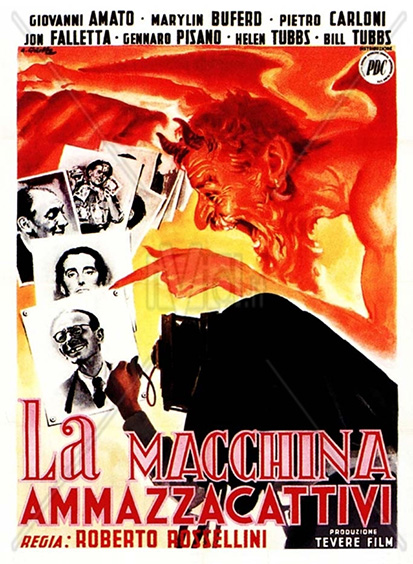I didn’t think that Roberto Rossellini’s one comedy “La macchina ammazzacattivi” (The machine [camera] that kills bad people), shot in 1948, i.e., between “Germany, Year Zero” and the arrival of Ingrid Bergman and “Stromboli,” but not released until 1952, was very funny. The Americans looking for a place to stay that has reliable indoor plumbing becomes tiresome quickly, as does the ogling of Marilyn Buferd (the 1946 Miss America, used here as a sort of proto-Anita Ekberg of Fellini’s later “La Dolce Vita,” a busty alien to excite the men and not called upon to act).

As the photographer Celestino Esposito who is provided by the local patron saint, Sant’Andrea, a method (photographing a photograph) to freeze (fatally) people in the position they were in in a photograph, Gennaro Pisano is reasonably ambivalent as he attempts to right wrongs in an Amalfi coast village. (He was the local coffin-maker, and Sant’Andrea an octogenarian local drunkard, Giovanni Amato.)
Those who offend the empowered photographer invariably overact. Greed is rampant, though the village and villagers have been poor until new blessings accompany mysterious sudden deaths. There’s also a very stupid Romeo and Juliet of a certain age.
Apparently, Rossellini was distracted (and strung out on cocaine) during the spasmodic shooting. He did not complete the black comedy that was released in a cut made by others. It has an artificial end to match the artificial opening and Rossellini probably wanted to say something about film-makers playing God, but couldn’t decide what he wanted to say, or realized that the comic low-tech magic was not adequate to the task.
The explicit moral is announced: “Don’t be too quick to judge and think about it three times before punishing [someone].”
Pros: look at late-1940s Italian coastal village
Cons: not very funny a comedy
(There is no region-1 DVD currently available. Indeed, the movie was thought to be lost for decades.)
©2019, Stephen O. Murray
